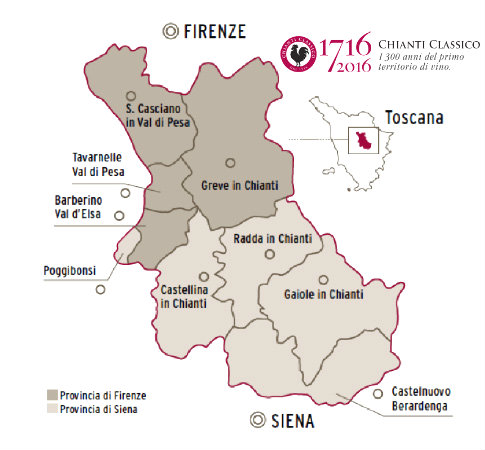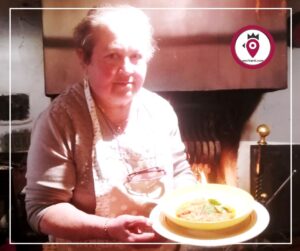Articolo disponibile anche in: Italian
We’ve recently met Bill Nesto and Francis di Savino, the authors of “Chianti Classico: The Search for Tuscany’s Noblest Wine”. Published in 2016, this is the most exhaustive book written about the Chianti territory up until now.
Where did your idea come from, and what were your motivations?
Di Savino (DS): “We both have very close ties with this land, and we felt that our mission would be to understand its true history and recount it to the world, and to the people who are born here who don’t know the real roots of the Chianti. The book focuses on the history, culture and legal evolution, explaining how the Chianti Classico originated in the context of Italian wine laws. During the first research in Boston in 2014 we immediately realised that much of the history was still hidden, and our visits to the Archives of Siena and Florence confirmed our suppositions”.
Nesto (N): “We wanted to write this book for the new generations, because young people need to learn about their roots, the Chianti area needs to be aware of its own past. This is important for any future development, because only with a good foundation can we build a sturdy building. What drove us was curiosity. Many people believe what they read, without asking where the information comes from. We researched the original sources and discovered that in the history of Chianti many things have been hidden intentionally. It was investigative journalism, we were free to write what we wanted because we paid for our work out of our own pockets”.
Could you give an example?
DS: “The study of Girolamo da Fiorenzuola. A statement taken from the original manuscript, badly transcribed, created a false myth about the Sangiovese, that was repeated for three centuries by Tebaldi, Soderini, Davanzati and Villafranchi until 1967, when Dalmasso gave his famous speech at the Georgofili. In 1552 Fiorenzuola wrote that to make the precious wine of Tuscany, it was necessary to use the Sangiovese grape, grown in a single vineyard at a high altitude in the Chianti area. No one has ever referred to this until today”.
N: “He also wrote a Chianti wine recipe that is virtually the equivalent of the one used in the 1920’s. He had a clear understanding of the Chianti table wine and the superior Sangiovese Chianti wine. He also had a French wine recipe. The Italians have always looked to the world of French wines with both attraction and detachment. The same has happened in recent years: Tachis has introduced the French technologies and brought new wealth to this area, while Gambelli strongly believed in the Sangiovese grape and contributed to its rehabilitation”.
Why this confusion between Chianti and Chianti Classico?
DS: “At the beginning of the last century the concept of “vino tipico” (“typical wine”) was the perfect legal construct to protect wines that were similar to the original Chianti wines but that were not produced in the Chianti region. The question is: how can a law of the ‘30’s still be valid today within the European Union legislation, especially considering that the Chianti Classico area has been recognized as a “Distretto rurale” (rural district) and will run for the UNESCO heritage recognition? Gino Sarrocchi was already asking this question in 1942″.
N: “More than 70 members of the Consorzio produce Chianti and Chianti Classico. There is more profit in producing Chianti than Chianti Classico wines, and it’s beneficial for many producers not to limit themselves to one of the two. We have to keep in mind that there are very large and important wine producers in this area but also very small ones who obviously have different ways of operating”.

What do you think of the zoning proposal?
N: “Chianti Classico needs strong roots from which to develop. As an example, the Gran Selezione was simply a commercial idea promoted by large producers who had a lot of Riserva wines in their cellars. The idea of the geographical sub-zones is instead a first step towards defining the territory. In Panzano, for example, they have done a good job, but this needs to be done with care, because it’s dangerous to start creating small denominations without first defining the foundations on which they are based”.
Why is it that a document as important as the ban of Cosimo III has been ignored for so long?
DS: “To quote Professor Italo Moretti: “It was an inconvenience”. It was inconvenient for the traditionalists of Radda, Gaiole and Castellina because the ban acknowledged the existence of Panzano, Lamole and Greve as part of the Chianti wine region, it was inconvenient for San Casciano that was not included (even if the geographical boundaries were not clearly defined), and in general for the Grand Duchy and for Italy”.
Will there ever be a version of the book in Italian, as many hope?
N: “We don’t know. Translating this work into Italian wouldn’t be easy, and would require a serious effort on our part. I wonder if it would be in the interest of a public institution to sponsor a good translation. I think it would mean a lot for this territory “.
Emanuele Grazzini


